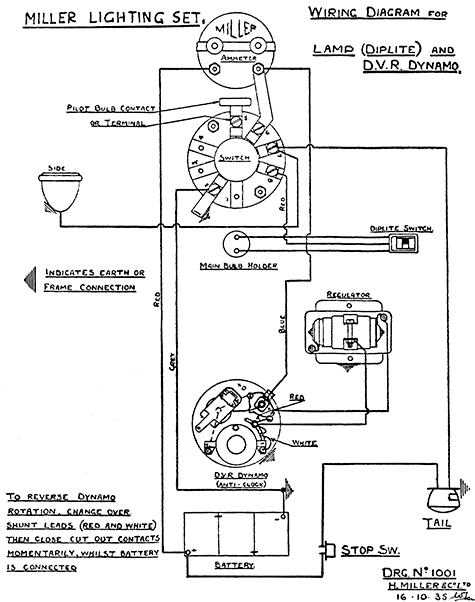Battery Maintenance. Provided that the battery has been filled and charged for the first time exactly to the makers' instructions, it should need only a little routine attention to remain in good order.
Top up with distilled water regularly, usually every 1,000 miles, or more frequently in warm weather. It is easier to do this if the battery is removed.
Take off the lid and unscrew the three vent plugs from the battery top.
If a Varley battery is fitted there will be no free liquid in the cells, but the filling which is visible should be moist. Add a little distilled water to each cell. About a teaspoonful in each. Allow this to become absorbed before adding more. When the cells will not absorb any more water after standing about ten minutes shake out all excess, dry the top and replace the plugs. Refit the battery. The topping up should be done when it is needed after a journey, not before starting.
The level of the liquid in " wet " batteries such as Exide, Lucas, etc., must be high enough for the plates to be covered. A Lucas battery filler is obtainable which will automatically top up the cells the right amount. Failing this bring the level up to cover the plates, but not to cover the separators which stand higher and are often mistaken for them.
" Wet " batteries are best topped up before a journey. See that the terminals are clean, free from corrosion, and tight. Smear lightly with vaseline to prevent corrosion.
Before starting up check by switching on the lights that the battery is correctly connected. (Black —) negative to frame The ammeter should show a discharge. If a " charge " is indicated switch off at once and correct the wiring. A wiring diagram is on page 66.
Battery Storage. If the motor-cycle is laid up for longer than a month the battery should be taken off and charged. Regular freshening charges will be required if storage continues. Do not in any circumstances empty the battery—this will ruin it.
At the commencement of storage, top up as already explained, charge on a charging installation until fully charged. Clean and dry thoroughly, clean the terminals and coat with vaseline. Give livening charges of 8 hours at 1 ampere monthly and keep topped up.
Headlamp. This carries two bulbs; the main double filament (bifocal) bulb, and the small parking bulb of much lower power.
To change a bulb release the spring clip underneath the lamp rim and pull the rim away from the lamp body at the bottom front. The Rim will bring the reflector and bulb holder with it.
Remove the bulb holder by releasing the spring clips holding it to the reflector, and hingeing these back out of the way. The bulb holder will pull out of the reflector giving access to the bulbs.
The main bulb is a 6-volt 24-24 watt double filament (Type S.B.C.) and the parking bulb a 6-volt 3-watt single filament single contact (Type S.C.C.)
When fitting a new headlamp bifocal bulb note the marking " Top " on the bayonet cap and fit so that this is at the top.
Avoid touching the highly polished surface of the reflector as it will finger mark very easily and such marks will be difficult to remove without causing permanent damage to the reflecting surface.
Rear Lamp and Stoplight. To change a bulb, prise out the wire circlip from inside the lip of the lamp rim and take out the plated fret and ruby disc.
When replacing engage the projection on the fret in the slot in the lamp, and make quite certain that the circlip is securely seated under the lip and its bent out end in the slot.
The bulbs used in the Rear Lamp and Stoplight are both 6-volt, 3-watt single contact (Type S.C.C.).
Dynamo. If the charging is satisfactory it is advisable to leave well alone. The condition of the commutator and brushes should be checked occasionally and the segments of the former polished up if blackened. In any case carry out an inspection after 10,000 miles running. Before any inspection remove the positive lead from the battery.
Remove the commutator cover from the end of the dynamo remote from the drive by pulling out the single pin plug and taking out the cover centre screw.
The brushes must work freely in the brush holders, and if worn down so that they do not bear on the commutator evenly, or expose the embedded ends of the flexible lead on the running face they must be renewed.
Stiffness may be rectified by removing the tight brush and cleaning the sides with a petrol-moistened cloth, or by rubbing lightly on fine glass paper.

Clean all traces of oil or dirt from the commutator by pressing a cloth against it whilst rotating the engine with the kickstart. If very dirty use some petrol on the cloth. If blackened or ridged clean up by polishing with a strip of glass paper wrapped around the commutator segments. Note that if considerable polishing is done the mica inserts may need undercutting; a job for a Miller Service Agent.
New brushes must be bedded down to the commutator before use and the work should be handed over to the nearest Service Agent.
Always, when refitting old brushes, see that they go back into their original positions.
The Automatic Voltage Regulator. This should need no attention at all in normal service, but if suspected of being at fault first check the dynamo belt adjustment. See page 32.
The symptoms of defective regulation, i.e., under charging, may be caused by the belt slipping due to faulty adjustment—see page 32.

